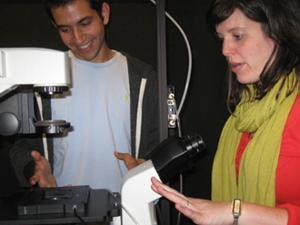Fighting Fossil Fuels with Functional Feng Shui
Stained glass isn’t just one of the world’s oldest art forms; it may also be the key to solving the energy crisis.
As global populations soar, the Earth’s energy demand is at its highest. Over 85% of this energy comes from burning fossil fuels, and as a result, greenhouse gas emissions are climbing. Little do we realize every hour the sun provides more energy than humans can use in a single year. If only there was a way for us to harvest this potential energy source.
Traditionally, people have turned to silicon-based solar cells, those unsightly block roof attachments that you may have noticed, as a popular light harvesting solution. But not only are they – let’s face it - ugly, these silicon cells are also relatively inefficient and costly. In order for solar energy to take root, we need a solution that is not only a great decorative piece, but is also more cost effective.
The answer to our energy needs may come in the form of a translucent, stained-glass window with the ability to harness sunlight via dyes and in turn generate electricity. Coined “Dye-Sensitized Solar Cells” (DSSCs) by their Norwegian inventor, Michael Gratzel, the cells can ideally be manufactured using cheap materials that are also biodegradable. Scientific advances are finally allowing DSSCs to match the energy output of silicon-based solar cells, but current limitations in dye development means there is still a long way to go before you’ll see these functional feng shui pieces popping up.
Much like how plant photosynthesis is dependent on green dyes in chloroplasts, DSSC energy production is dependent on colored dyes. Just like a chloroplast, dyes on the surface of DSSCs harvest the sun’s energy in the form of electrons. While plant dyes will pass these electrons onto other proteins, the dyes in these solar cells pass them on to a microscopically thin layer of titanium dioxide, which uses these electrons to generate electricity. As night falls, plants will have produced sugars for growth, while DSSCs will have provided power to your home.
While dyes may allow you to decorate rooms with solar cells in the future, their natural abundance is also a source of scientific excitement. However, while there is a wealth of dyes available to color your clothes, finding dyes that can form the right kinds of interactions with the conductive pane is a difficult task.
Gratzel’s first cell was made using a red ruthenium-based dye. Unlike the molecules coloring your shirt, ruthenium is a rare metal, costing about $60 an ounce. Its use in DSSCs would drive the price of this technology over current solar cell prices. Chemists are currently working on uncovering more cost effective dyes capable of pairing with the conductive panes. Promising alternatives include nickel and zinc based dyes, both of which are under $10 a pound.
Even more exciting is the potential for organic dyes, molecules comprised of solely carbon, nitrogen or oxygen, which have the ability to gather sunlight. Such molecules would not only expand the dye-pool, but they would also increase the cost effectiveness of the product, as organic molecules are often cheaper than their inorganic counterparts.
 Despite the sheer number of potential dye sources available, very little progress has been made on increasing the electrical output of DSSCs. Since their discovery in 1991, DSSCs have only just begun to increase in terms of energetic efficiency, but they still have a long way to go before they’ll rival silicon-based solar cells. This poor rate of improvement is largely due to inadequate human resources – it takes years to comb through the enormous volume of dyes out there, and there are still many more molecules to explore. The problem starts to look like the old needle-in-a-haystack. Thankfully, Dr. Kristin Wustholz, Assistant Professor of Chemistry at The College of William and Mary, is developing a way to locate the needle without the need to sift through all that hay.
Despite the sheer number of potential dye sources available, very little progress has been made on increasing the electrical output of DSSCs. Since their discovery in 1991, DSSCs have only just begun to increase in terms of energetic efficiency, but they still have a long way to go before they’ll rival silicon-based solar cells. This poor rate of improvement is largely due to inadequate human resources – it takes years to comb through the enormous volume of dyes out there, and there are still many more molecules to explore. The problem starts to look like the old needle-in-a-haystack. Thankfully, Dr. Kristin Wustholz, Assistant Professor of Chemistry at The College of William and Mary, is developing a way to locate the needle without the need to sift through all that hay.
Armed with a high-powered microscope, Wustholz has been zooming-in on these dyes, probing for particularly exemplary, and not-so-exemplary, molecules. Through this process, she’s gathering data on which molecular characteristics work to enhance DSSC energy harvesting, and which do not. In doing so, she’ll be able to help guide the synthesis of more ideal dyes. Hopefully such an approach is the key to accelerating DSSCs beyond their traditional silicon based solar cell rivals.
With Wustholz’s research underway, decorating your house in the future could also mean color-coordinating which dye-sensitized solar cell you install in your windows. Not only will this technology brighten your rooms, they’ll also help combat our global energy costs.
 Skip to main content
Skip to main content
